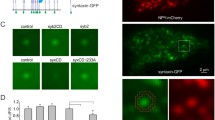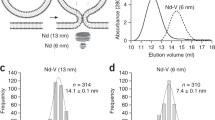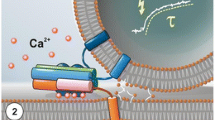Abstract
The SNARE complex, involved in vesicular trafficking and exocytosis, is composed of proteins in the vesicular membrane (v-SNAREs) that intertwine with proteins of the target membrane (t-SNAREs). Our results show that modified large dense-core neurosecretory granules (NSGs), isolated from the bovine neurohypophysis, spontaneously fuse with a planar lipid membrane containing only the t-SNARE syntaxin 1A. This provides evidence that syntaxin alone is able to form a functional fusion complex with native v-SNAREs of the NSG. The fusion was similar to constitutive, not regulated, exocytosis because changes in free [Ca2+] had no effect on the syntaxin-mediated fusion. Several deletion mutants of syntaxin 1A were also tested. The removal of the regulatory domain did not significantly reduce spontaneous fusion. However, a syntaxin deletion mutant consisting of only the transmembrane domain was incapable of eliciting spontaneous fusion. Finally, a soluble form of syntaxin 1A (lacking its transmembrane domain) was used to saturate the free syntaxin-binding sites of modified NSGs. This treatment blocks spontaneous fusion of these granules to a bilayer containing full-length syntaxin 1A. This method provides an effective model system to study possible regulatory components affecting vesicle fusion.
Similar content being viewed by others
References
Woodbury, D. J. and Rognlien, K. (2000). Syntaxin: sufficient t-SNARE for spontaneous fusion of synaptic vesicles to planar membranes. Cell Biol. Int., 24(11), 809–818.
Rognlien, K. T. and Woodbury, D. J. (2003) Reconstituting SNARE proteins into BLMs, in Planar Lipid Bilayers (BLMs) and Their Applications Tien, H. T. and Ottova-Leitmannova, A., eds.), Membrane Science and Technology Series, Elsevier, Amsterdam, pp. 479–488.
Woodbury, D. J. (1999b) Building a bilayer model of the synapse. Cell. Biochem. Biophys., 30, 303–329.
Jahn, R., Lang, T., and Sudhof, T. C. (2003) Membrane fusion. Cell, 112, 519–533.
Söllner, T., Whiteheart, S. W., Brunner, M., et al. (1993) SNAP receptors ilmplicated in vesicle targeting and fusion. Nature, 362, 318–324.
Südhof, T. C. (1995) The synaptic vesicle cycle: a cascade of protein-protein interactions. Nature 375, 645–653.
Schiavo, G., Steinbeck, G., Rothman, J. E., and Söllner, T. H. (1997) Binding of the synaptic vesicle V-SNARE, SNAP-25, can explain docked vesicles at neurotoxin treated synapses. Proc. Natl. Acad. Sci. USA., 94, 997–1001.
Zhong, P., Chen, Y. A., Tan, D., Chung, D., Scheller, R. H., and Miljanich, G. P. (1997) An alpha-helical minimal binding domain within the H3 domain of syntaxin is required for SNAP-25 binding. Biochemistry, 36(14), 4317–43126.
Weber, T., Zemelman, B. V., McNew, J. A., et al., (1998) SNAREpins: minimal machinery for membrane fusion. Cell, 92, 759–772.
Hoffman, K. (1998) A model for structural similarity between different SNARE complexes based on sequence relationships. Cell Biol., 8, 260–262.
Ungerman, C., Nichols, B. J., Pelham, H. R. B., and Wickner, W. (1998) A vacuolor V-T-SNARE complex, the predominant form in vivo and on isolated vacuoles, is disassembled and activated for docking and fusion. J. Cell Biol., 40, 61–69.
Parlati, F., Weber, T., McNew, J. A., Westermann, B., Sollner, T. H., and Rothman, J. E. (1999), rapid and efficient fusion of phospholipid vesicles by the alpha-helical core of a SNARE complex in the absence of an N-terminal regulatory domain. Proc. Natl. Acad. Sci. USA, 96(22), 12,565–12,570.
Nicholson, K. L., Munson, M., Miller, R. B., Filip, T. J., Fairman, R., and Hughson, F. M. (1998) regulation of SNARE complex assembly by an N-terminal domain of the t-SNARE Sso1p. Naure Struct. Biol., 5(9), 793–803.
Rizzo, J. and Sudhof, T. C. (2002) SNAREs and Munc18 in synaptic vesicle fusion. Nature Rev., 3, 641–653.
Hu, K., Carroll, J., Fedorovich, S., Rickman, C., Sukhodub, A., and Davletov, B. (2002) Vesicular restriction of synaptobrevin suggests a role for calcium in membrane fusion. Nature, 415(6872), 646–650.
Chapman, E. R. (2002) Synaptotagmin: a calcium sensor that triggers exocytosis? Nature Reviews., 3, 1–11.
Tucker, W. C., Weber, T., and Chapman, E. R. (2004) Reconstitution of calcium regulated membrane fusion by synaptotagmin and SNAREs. Science., 304, 435–438
Kelly, M. and Woodbury, D. J. (1996) Ion channels from synaptic vesicle membrane fragments reconstituted into lipid bilayer. Biophys. J., 70(6), 2593–2599.
Perin, M. S. and MacDonald, R. C. (1989) Fusion of synaptic vesicle membranes with plenar bilayer membranes. Biophys. J., 55(5), 973–986.
Woodbury, D. J. and Miller, C. (1990) Nystatin-induced liposome fusion: a versatile approach to ion channel reconstitution into planar bilayers. Biophys. J., 58, 833–839.
Woodbury, D. J. (1999) Nystatin/ergosterol method for reconstituting ion channels into planar lipid bilayers. Methods Enzymol., 294, 319–339.
Nordman, J. J., Louis, F., and Morris, S. J. (1979) Purification of two structurally and morphologically distinct populations of rat neurohypophysial secretory granules. Neuroscience, 4, 1367–1375d.
Lee, C. J., Dayanithi, G., Nordmann J. J., and Lemos, J. R. (1992) Possible role during exocytosis of a Ca2+-activated channel in neurohy-pophysial granules. Neuron, 8, 335–342.
Lemos, J. R., Ocorr, K. A., and Nordman, J. J. (1989) Possible role during exocytosis of a Ca2+-activated channel in neurohypophysial granules. Neuron, 8, 335–342.
Stanley, E. F., Ehrenstein, G., and Russell, G. T. (1988) Evidence for anion channels in secretory vesicles. Neuroscience., 25, 1035–1039.
Yin, Y., Dayanithi, G., and Lemos, J. R. (2002) Ca2+-regulated synaptophysin-like channel involved in release from nerve terminals. J. Physiol. 539(2), 409–418d.
Woodbury, D. J. and Kelly, M. J. (1994) Release of ATP from cholinergic synaptic vesicles during freeze-thaw cycling. Cryobiology, 31, 279–289.
Langosch, D., Crane, J. M., Brossig, B., Hellwig, A., Tamm, L. K., and Reed, J. (2001) Peptide mimics of SNARE transmembrane segments drive membrane fusion depending on their conformational plasticity. J. Mol. Biol., 311, 709–721.
Fasshauer, D. (2003) Structural insights into the SNARE mechanism. Biochim. Biophys. Acta. 1641, 87–97.
McNally, J. M., Woodbury, D. J., and Lemos, J. R. (2003). Syntaxin mutants modulate fusion of dense core granules to a planar lipid bilayer. Biophys. J., 81, A950.
Poirier, M. A., Xiao, W., Macosko, J. C., Chan, C., Shin, Y., and Bennet, M. K. (1998) The synaptic SNARE complex is a parallel fourstranded helical bundle. Nature Struct. Biol. 5(9), 765–769.
Weis, W. I. and Scheller, R. H. (1998) Membrane fusion. SNARE the rod, coil the complex. Nature 395(67), 328–329.
Nichols, B. J., Ungermann, C., Pelham, H. R., Wickner, W. T., and Haas, A. (1997) Homotypic vacuolar fusion mediated by t- and v-SNAREs. Nature, 387(6629), 199–202.
Misura, K. M. S., Scheller, R. H., and Weis, W. I. (2001) Self association of the H3 region of syntaxin 1A. J. Biol. Chem., 276(16), 13,273–13,282.
McNew, J. A., Weber, T., Parlati, F., et al. (2000). Close is not enough: SNARE-dependent membrane fusion requires an active mechanism that transduces force to membrane anchors. J. Cell Biol., 150(1), 105–117.
Melia, T. J., Weber, T., McNew, J. A., et al. (2002) Regulation of membrane fusion by the membrane-proximal coil of the t-SNARE during zippering of SNAREpins. J. Cell Biol., 158(8), 929–940.
Author information
Authors and Affiliations
Corresponding author
Rights and permissions
About this article
Cite this article
McNally, J.M., Woodbury, D.J. & Lemos, J.R. Syntaxin 1A drives fusion of large dense-core neurosecretory granules into a planar lipid bilayer. Cell Biochem Biophys 41, 11–23 (2004). https://doi.org/10.1385/CBB:41:1:011
Issue Date:
DOI: https://doi.org/10.1385/CBB:41:1:011




